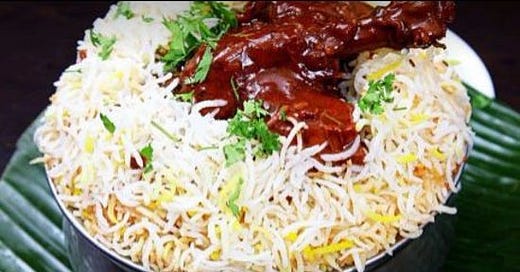In the kaleidoscope of Indian gastronomy, biryani stands tall as a gastronomic masterpiece, celebrated for its opulent flavors and fragrant spices. Among the diverse regional renditions, Ulavacharu Biryani emerges as a culinary gem, enchanting palates with a harmonious fusion of tradition and contemporary flair. This article embarks on an exploration of the origins, ingredients, and irresistible allure that define Ulavacharu Biryani
Ulavacharu Biryani traces its roots to the southern part of India, particularly the states of Andhra Pradesh and Telangana. The word "Ulavacharu" translates to "horse gram soup" in Telugu, a language spoken in these regions. The biryani gets its name from the distinctive horse gram-based soup that is a crucial component of the dish.
What sets Ulavacharu Biryani apart is not just its name but also its unique set of ingredients. The key components include basmati rice, horse gram, aromatic spices, and tender meat (usually chicken or mutton). The horse gram soup, prepared separately, serves as the base for cooking the rice, infusing it with a distinct earthy flavor.
The preparation of Ulavacharu Biryani involves a meticulous process, showcasing the culinary expertise of the region. The rice is parboiled with the horse gram soup, enhancing its nutritional profile and lending a subtle nutty taste. The marinated meat, seasoned with a blend of spices like cloves, cardamom, cinnamon, and bay leaves, is layered over the rice, creating a harmonious marriage of flavors.
Ulavacharu Biryani is celebrated for its intricate layers of flavors that unfold with each mouthful. The horse gram soup imparts a unique earthiness to the dish, elevating it beyond the ordinary. The aromatic spices, combined with the slow-cooked meat, create a melange of tastes that dance on the palate – spicy, tangy, and subtly smoky.
The slow-cooking process allows the meat to absorb the essence of the spices, resulting in succulent, tender bites. The basmati rice, infused with the horse gram soup, adds a delightful texture and a hint of nuttiness, complementing the robust flavors of the meat.
While Ulavacharu Biryani remains deeply rooted in tradition, chefs and home cooks alike have added their own creative twists to the recipe. Some variations include the use of fragrant ghee or the addition of caramelized onions for an extra layer of sweetness. Vegetarian renditions with ingredients like paneer or mixed vegetables showcase the adaptability of this traditional dish.
In recent times, the popularity of Ulavacharu Biryani has transcended regional boundaries, finding its way into the menus of upscale restaurants and the hearts of food enthusiasts. The dish's unique profile, with its combination of heritage and innovation, makes it a standout choice for those seeking a memorable culinary experience.
Beyond its delectable taste, Ulavacharu Biryani brings a host of health benefits, courtesy of its star ingredient – horse gram. Known for its high protein and low-fat content, horse gram is a nutritional powerhouse. It is also rich in fiber, aiding digestion and promoting a sense of fullness.
The use of aromatic spices not only enhances the flavor but also adds a dose of health benefits. Spices like cloves and cardamom are known for their antioxidant properties, while cinnamon may help regulate blood sugar levels. The slow-cooking process retains the nutritional value of the ingredients, making Ulavacharu Biryani a wholesome and satisfying meal.
As this traditional dish continues to evolve with modern interpretations, it not only delights the taste buds but also offers a glimpse into the cultural richness of Indian cuisine. Whether enjoyed at a family gathering or savored at a fine-dining restaurant, Ulavacharu Biryani remains a culinary masterpiece that celebrates tradition while embracing the spirit of innovation.





